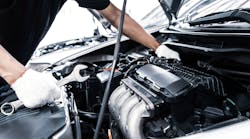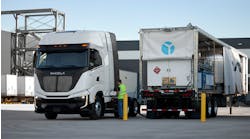Each year, the Car Care Council designates one month in the spring (April) and one month in the fall (October) to call awareness to the importance of regular vehicle care. Routine maintenance checks can help prevent breakdowns and premature vehicle component failure. This rule of thumb also applies to commercial fleets, which often endure long hours on the road and are exposed to extreme temperatures—such as sleet and snow—as the weather begins to cool. An often-overlooked component, which is key to the performance of heavy-duty vehicle fleets, is the battery. It not only keeps the engine running, but it is also responsible for operating critical onboard accessories, such as the air conditioning, GPS, communications systems, liftgates, and more.
Below are some tips fleet operators can follow. Always be sure to follow the manufacturer’s guidelines for battery care and handling and direct any questions to your battery professional.
Check electrolyte levels
Conventional flooded lead acid batteries require periodic electrolyte replenishment with water, which requires an investment of time for municipal workers to check and maintain the batteries.
Clean and inspect the condition of the battery
Keeping the battery free of acid and corrosion may improve performance in the cold weather months. When cleaning, remember to disconnect the battery and wear protective safety gear. Use a battery terminal brush to clean away deposits and baking soda paste to neutralize acid accumulation. Check the case, terminals, cables, and clamps for damage from acid and corrosion. Replace damaged cables and clamps, but if the case or terminals are damaged, replace the battery.
Check the battery’s charge
The battery should be fully charged, which is typically at 12.8V, to minimize sulfation. Measure the battery’s voltage with a voltmeter to determine the Open Circuit Voltage (OCV). Manufacturer specifications will indicate what OCV corresponds to 100% State of Charge (SOC). If the battery needs to be charged, manufacturer specifications will provide the proper level of charge.
The key to protecting any battery from freezing is to make sure it stays fully charged throughout the fall and winter. If the battery is used sporadically, and left to discharge during this time, the electrolyte begins to change from acid to water as the voltage declines. The more water-like the electrolyte becomes, the easier it is to freeze.
Perform a load test
Load testing a battery will tell you if it’s in good condition for the fall and winter season. If you don’t have a load tester, take it somewhere that can perform the load test.
Whether flooded or Absorbed Glass Mat (AGM), the reliability of conventional lead acid batteries can be compromised when handling the additional demands the auxiliary systems and extreme cold weather place on them. Non-spillable, AGM ODYSSEY batteries, manufactured with Thin Plate Pure Lead (TPPL) technology, are engineered to handle the increased demand for powering accessories and the extreme weather conditions brought on by the winter cold. TPPL technology uses pure lead plates, which can be made thinner to increase the active surface area, providing maximum power performance. ODYSSEY batteries also tolerate extreme temperatures, from -40°F (-40°C) to 140°F (60°C).
As a result of their design and AGM construction, ODYSSEY batteries are resistant to high-impact shock and vibration, two common concerns that can impact the longevity of a battery. They provide deep cycle reserve power and maximum cranking power, with engine cranking pulses up to 2,700 amps for five seconds.
Information provided by: EnerSys



